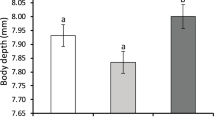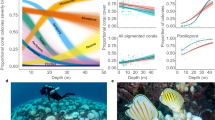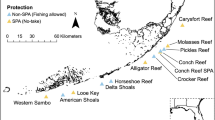Abstract
Mass coral bleaching causes population declines and mortality of coral reef species1 yet its impacts on behaviour are largely unknown. Here, we unite behavioural theory with community ecology to test whether bleaching-induced mass mortality of corals can cause consistent changes in the behaviour of coral-feeding fishes. We documented 5,259 encounters between individuals of 38 Chaetodon (butterflyfish) species on 17 reefs within the central Indo-Pacific, of which 3,828 were repeated on 10 reefs both before and after the global coral bleaching event in 2016. Aggression between butterflyfishes decreased by two-thirds following large-scale coral mortality, despite no significant change in fish abundance or community composition. Pairwise encounters were most likely to be aggressive between obligate corallivores and on reefs with high coral cover. After bleaching, the proportion of preferred Acropora corals in the diet decreased significantly (up to 85% fewer bites), with no increase in overall bite rate to compensate for the loss of these nutritionally rich corals. The observed reduced aggression at low resource levels due to nutritional deficit follows the predictions of the economic theory of aggressive behaviour2,3. Our results reveal synchronous changes in behaviour in response to coral mortality. Such changes could potentially disrupt territories4, leading to reorganization of ecological communities.
This is a preview of subscription content, access via your institution
Access options
Access Nature and 54 other Nature Portfolio journals
Get Nature+, our best-value online-access subscription
$29.99 / 30 days
cancel any time
Subscribe to this journal
Receive 12 print issues and online access
$209.00 per year
only $17.42 per issue
Buy this article
- Purchase on Springer Link
- Instant access to full article PDF
Prices may be subject to local taxes which are calculated during checkout





Similar content being viewed by others
Data availability
The data that support the findings of this study are available from the corresponding author upon request.
References
Pratchett, M. S. et al. in Oceanography and Marine Biology: An Annual Review Vol. 46 (eds Gibson, R. N. et al.) 251–296 (CRC, Boca Raton, 2008).
Peiman, K. S. & Robinson, B. W. Ecology and evolution of resource-related heterospecific aggression. Q. Rev. Biol. 85, 133–158 (2010).
Maher, C. R. & Lott, D. F. A review of ecological determinants of territoriality within vertebrate species. Am. Midl. Nat. 143, 1–29 (2000).
Samways, M. J. Breakdown of butterflyfish (Chaetodontidae) territories associated with the onset of a mass coral bleaching event. Aquat. Conser. Mar. Freshw. Ecosyst. 15, S101–S107 (2005).
Hughes, T. P. et al. Global warming and recurrent mass bleaching of corals. Nature 543, 373–377 (2017).
Graham, N. A. J., Jennings, S., MacNeil, M. A., Mouillot, D. & Wilson, S. K. Predicting climate-driven regime shifts versus rebound potential in coral reefs. Nature 518, 94–97 (2015).
McClanahan, T. R., Weil, E., Cortés, J., Baird, A. H. & Ateweberhan, M. in Coral Bleaching: Patterns, Processes, Causes and Consequences (eds van Oppen, M. J. H. & Lough, J. M.) 121–138 (Springer, Berlin, 2009).
Hughes, T. P. et al. Spatial and temporal patterns of mass bleaching of corals in the Anthropocene. Science 359, 80–83 (2018).
Nagelkerken, I. & Munday, P. L. Animal behaviour shapes the ecological effects of ocean acidification and warming: moving from individual to community-level responses. Glob. Change Biol. 22, 974–989 (2016).
Keith, S. A. & Bull, J. W. Animal culture impacts species’ capacity to realise climate-driven range shifts. Ecography 40, 296–304 (2017).
Grether, G. F., Peiman, K. S., Tobias, J. A. & Robinson, B. W. Causes and consequences of behavioral interference between species. Trends Ecol. Evol. 32, 760–772 (2017).
Gause, G. F. The Struggle for Existence (Williams and Wilkins, Baltimore, 1934).
Allan, B. J. M., Domenici, P., Watson, S. A., Munday, P. L. & McCormick, M. I. Warming has a greater effect than elevated CO2 on predator-prey interactions in coral reef fish. Proc. R. Soc. B 284, 20170784 (2017).
Hughes, T. P. et al. Coral reefs in the Anthropocene. Nature 546, 82–90 (2017).
Browman, H. I. Applying organized scepticism to ocean acidification research. ICES J. Mar. Sci. 73, 529–536 (2016).
Sundin, J. et al. Long-term exposure to elevated carbon dioxide does not alter activity levels of a coral reef fish in response to predator chemical cues. Behav. Ecol. Sociobiol. 71, 108 (2017).
Connell, J. H. in Experimental Marine Biology (ed. Mariscal, R.) 21–54 (Academic, New York, 1974).
Maynard Smith, J. Evolutionary Game Theory (Cambridge Univ. Press, Cambridge, 1982).
Blowes, S. A., Pratchett, M. S. & Connolly, S. R. Heterospecific aggression and dominance in a guild of coral-feeding fishes: the roles of dietry ecology and phylogeny. Am. Nat. 182, 157–168 (2013).
Yabuta, S. & Berumen, M. L. in Biology of Butterflyfishes (eds Pratchett, M. S. et al.) 200–225 (CRC, Boca Raton, 2014).
Stamps, J. A. The relationship between resource competition, risk, and aggression in a tropical territorial lizard. Ecology 58, 349–358 (1977).
Toms, J. D. Linking behavior and community ecology: interspecific aggression provides evidence for competition between a migrant and resident warbler. Ethology 119, 1057–1066 (2013).
Darwin, C. On the Origin of Species by Means of Natural Selection, or the Preservation of Favoured Races in the Struggle for Life (John Murray, London, 1859).
Biro, P. A., Beckmann, C. & Stamps, J. A. Small within-day increases in temperature affects boldness and alters personality in coral reef fish. Proc. R. Soc. B 277, 71–77 (2010).
Pratchett, M. S. in Biology of Butterflyfishes (eds Pratchett, M. S. et al.) 140–179 (CRC, Boca Raton, 2014).
Marshall, P. A. & Baird, A. H. Bleaching of corals on the Great Barrier Reef: differential susceptibilities among taxa. Coral Reefs 19, 155–163 (2000).
Vahl, W. K., Lok, T., van der Meer, J., Piersma, T. & Weissing, F. J. Spatial clumping of food and social dominance affect interference competition among ruddy turnstones. Behav. Ecol. 16, 834–844 (2005).
Pratchett, M. S., Wilson, S. K. & Baird, A. H. Long-term monitoring of the Great Barrier Reef. J. Fish. Biol. 69, 1269–1280 (2006).
Pratchett, M. S., Wilson, S. K., Berumen, M. L. & McCormick, M. I. Sublethal effects of coral bleaching on an obligate coral feeding butterflyfish. Coral Reefs 23, 352–356 (2004).
Bonin, M. C., Boström-Einarsson, L., Munday, P. L. & Jones, G. P. The prevalence and importance of competition among coral reef fishes. Annu. Rev. Ecol. Evol. Syst. 46, 169–190 (2015).
Chandler, J. F., Burn, D., Berggren, P. & Sweet, M. J. Influence of resource availability on the foraging strategies of the triangle butterflyfish Chaetodon triangulum in the Maldives. PLoS One 11, e0151923 (2016).
Tricas, T. C. Determinants of feeding territory size in the corallivorous butterflyfish, Chaetodon multicinctus. Anim. Behav. 37, 830–841 (1989).
Nash Suding, K. & Goldberg, D. Do disturbances alter competitive hierarchies? Mechanisms of change following gap creation. Ecology 82, 2133–2149 (2001).
Tinbergen, N. The functions of territory. Bird Study 4, 14–27 (1957).
Berumen, M. L. & Pratchett, M. S. Recovery without resilience: persistent disturbance and long-term shifts in the structure of fish and coral communities at Tiahura Reef, Moorea. Coral Reefs 25, 647–653 (2006).
Berumen, M. L. & Pratchett, M. S. Effects of resource availability on the competitive behaviour of butterflyfishes (Chaetodontidae). In Proc. 10th International Coral Reef Symposium (ed. Suzuki, Y.) 644–650 (Japanese Coral Reef Society, 2006).
Pink, J. R. & Fulton, C. J. Fin spotting: efficacy of manual and video-based visual assessments of reef fish swimming behaviour. J. Exp. Mar. Bio. Ecol. 465, 92–98 (2015).
Kulbicki, M. How the acquired behaviour of commercial reef fishes may influence the results obtained from visual censuses. J. Exp. Mar. Bio. Ecol. 222, 11–30 (1998).
Pratchett, M. S. Dietary overlap among coral-feeding butterflyfishes (Chaetodontidae) at Lizard Island, northern Great Barrier Reef. Mar. Biol. 148, 373–382 (2005).
vegan: Community Ecology Package v.1. 17-6 (R Foundation, 2011); http://CRAN.R-project.org/package=vegan
Hodge, J. R., van Herwerden, L. & Bellwood, D. R. Temporal evolution of coral reef fishes: global patterns and disparity in isolated locations. J. Biogeogr. 41, 2115–2127 (2014).
Paradis, E., Claude, J. & Strimmer, K. APE: analyses of phylogenetics and evolution in R language. Bioinformatics 20, 289–290 (2004).
rstanarm: Bayesian applied regression modeling via Stan (Stan Development Team, 2016); http://mc-stan.org/
Monnahan, C. C., Thorson, J. T. & Branch, T. A. Faster estimation of Bayesian models in ecology using Hamiltonian Monte Carlo. Methods Ecol. Evol. 8, 339–348 (2017).
Acknowledgements
We are grateful for funding support from VILLUM FONDEN (S.A.K., grant number 10114), the Danish National Research Foundation for support of the Center for Macroecology, Evolution and Climate (grant number DNRF96), and the Australian Research Council Centre of Excellence for Coral Reef Studies (AHB grant number CE140100020). For field assistance and logistical support, we thank N. Maginnis, L. Corner, T. Quimpo, V. Horigue and A. Roan; T. Naruse and R. Yoshida, the University of the Ryukyus Iriomote Field Station; Parks Australia and Christmas Island Divers Association; and R. Trono, A. Trono and staff of the Bontoc Seaview Guesthouse and Mabini Municipal Tourism Office, Batangas, Philippines. We also thank A. MacNeil for statistical advice and N. Graham and I. Hartley for constructive feedback on this manuscript.
Author information
Authors and Affiliations
Contributions
S.A.K. designed the study with input from J-P.A.H., A.H.B. and N.J.S.; S.A.K., J-P.A.H., A.H.B., E.S.W. and A.S.H. collected the data; N.F. provided fieldwork support; S.A.K. analysed the data and wrote the manuscript with contributions from all authors.
Corresponding author
Ethics declarations
Competing interests
The authors declare no competing interests.
Additional information
Publisher’s note: Springer Nature remains neutral with regard to jurisdictional claims in published maps and institutional affiliations.
Supplementary information
Supplementary Information
Supplementary figures 1–6, Supplementary table 1
Rights and permissions
About this article
Cite this article
Keith, S.A., Baird, A.H., Hobbs, JP.A. et al. Synchronous behavioural shifts in reef fishes linked to mass coral bleaching. Nature Clim Change 8, 986–991 (2018). https://doi.org/10.1038/s41558-018-0314-7
Received:
Accepted:
Published:
Issue Date:
DOI: https://doi.org/10.1038/s41558-018-0314-7
This article is cited by
-
A predictive timeline of wildlife population collapse
Nature Ecology & Evolution (2023)
-
Terrestrial invasive species alter marine vertebrate behaviour
Nature Ecology & Evolution (2023)
-
Ecological Effects of Predator Harvesting and Environmental Noises on Oceanic Coral Reefs
Bulletin of Mathematical Biology (2023)
-
Bleaching coral event due to cold waters in the Gulf of California: effect on Pocillopora cryptofauna
Coral Reefs (2023)
-
Fish and benthic communities in an offshore and well-managed coral reef after bleaching disturbance in the Philippines
Marine Biology (2023)



